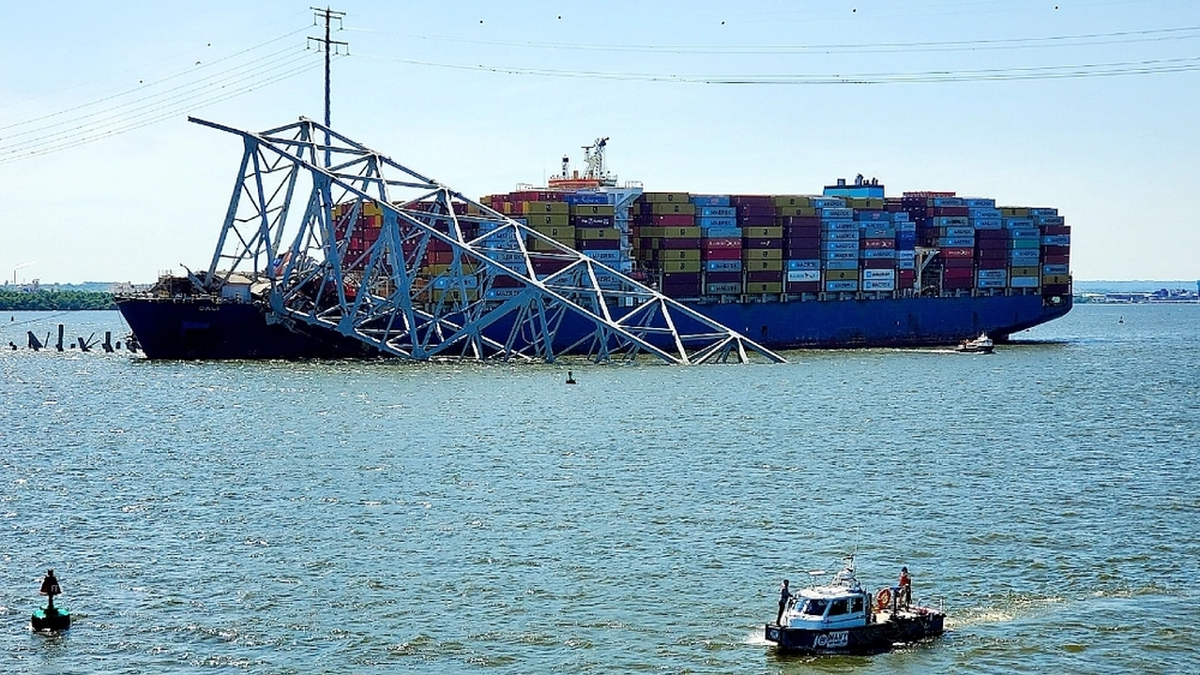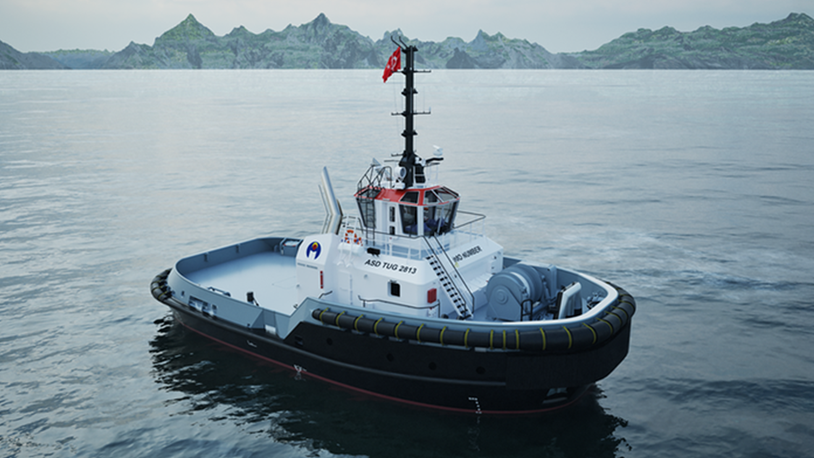Business Sectors
Events
Contents
NTSB report on Baltimore bridge collapse finds Dali had blackouts in port
A preliminary report from the US’ National Transportation Safety Board (NTSB) into the destruction of Baltimore’s Key Bridge confirmed the vessel that caused the bridge’s collapse suffered two blackouts on board within 10 hours of its departure from the port of Baltimore
The NTSB report said the first blackout on board Dali during the ship’s port stay in Baltimore occured during maintenance on a scrubber system, and the second blackout was linked to low fuel pressure in a backup generator.
Subsequent blackouts while the 9,962-TEU, Synergy Group-managed, Maersk-chartered container ship transited out of the port of Baltimore caused the vessel to strike Baltimore’s Francis Scott Key highway bridge, resulting in the bridge’s collapse.
The NTSB has yet to directly link the electrical problems on board the vessel during its port stay to the outages that caused the ship to lose power in transit.
"The NTSB is still investigating the electrical configuration following the first in-port blackout and potential impacts on the events during the accident voyage," the report said.
The report said the first blackout on board the vessel while it was in Baltimore happened after a crew member mistakenly closed an engine exhaust damper during maintenance. The maintenance work was taking place on the scrubber system for the diesel engine that was running the only online generator. A build-up of exhaust gases caused the engine to stall, resulting in a power failure.
Another generator automatically started, and crew members restored power, but insufficient fuel pressure in that generator resulted in a second blackout.
The NTSB said that, during both power outages, the generators’ circuit breakers to the high-voltage switchboard opened, or ’tripped’, before circuit breakers on redundant step-down transformers connecting a low-voltage switchboard to the high-voltage switchboard could.
As the crew took steps to recover power on board Dali during the power outages in port, they switched between two step-down transformers connecting the low-voltage system to the high-voltage switchboards. The NTSB report said this switch happened because the step-down transformer that had been in use, had been operating for an extended period.
"During the recovery, the crew put [transformer 1] online to feed the low-voltage bus because [transformer 2] had reportedly been in use for several months," the NTSB said.
The NTSB report followed its description of the causes of in-port power outages by saying that Dali’s first blackout after it left the port of Baltimore on 26 March, and as it approached the Key Bridge, was caused when a pair of circuit breakers on the step-down transformers unexpectedly opened, or ’tripped’.
Notably, the low-voltage system on board powers the lighting as well as the vessel’s steering gear pumps and the main engine’s water pump cooling system.
The NTSB said it will continue evaluating the design and operation of Dali’s power distribution system, including its breakers, will undertake detailed analysis of data and information from the vessel’s data recorders and will undertake further investigations into oceangoing vessels’ propulsion and electrical systems.
Examination of damage to Dali will continue when the ship is clear of debris and moved to a shoreside facility, according to NTSB.
On 13 May, salvors undertook a controlled demoliton of the section of steel bridge truss and highway pinning Dali in place.
Below the footage of the controlled demolition is a lightly edited version of the NTSB report’s timeline of the events in the moments leading up to, during and following Dali striking the Key Bridge and the bridge’s collapse.
"About 0125, Dali was 0.6 miles (1 km) – or three ship lengths – from the Key Bridge when electrical breakers that fed most of the vessel’s equipment and lighting unexpectedly opened (tripped). This caused the first blackout to all shipboard lighting and most equipment, including the main engine cooling water pumps (which controlled engine cooling water pressure) and steering gear pumps. Generators number three and four continued to run and supply electrical power to the high-voltage bus. Most bridge equipment also lost power, and the voyage data recorder (VDR) lost vessel system data feeds. Bridge audio continued to be captured.
"The main propulsion diesel engine was independent of the vessel’s four diesel-driven electrical generators; however, the loss of electrical power to the pumps required for its operation resulted in the main engine being automatically shut down, and the vessel lost main propulsion, meaning its propeller stopped.
"The loss of electrical power stopped all three steering pumps, and, therefore, the rudder was unable to be moved. At the time, the ship was on a heading of 141.7°, a course over ground of 140.8°, and speed over ground of 9.0 knots, with the rudder amidships (0°).
"At 0126:02, the VDR, which had stopped recording vessel system data when the blackout occurred, resumed recording the data. The VDR audio recording had not been affected by the blackout. Dali’s heading was 144.3° and course over ground was 142.7°. Its speed over ground was 8.6 knots. The apprentice pilot called
the pilot dispatcher by mobile phone. At 0126:13, the senior pilot, who had regained control from the apprentice pilot by this point, ordered 20° of port rudder.
"According to the crew, the emergency generator started and connected to the emergency bus (its breaker would have closed) shortly after the vessel lost electrical power. At this time, the NTSB is still investigating the exact time when the emergency generator started and connected to the emergency bus. Typical for oceangoing vessels, Dali had an emergency diesel generator (in addition to the four generators) that could be configured to automatically start and connect to the emergency bus if normal electrical power and lighting were lost. When the emergency bus was powered, emergency lighting, navigation and radio equipment, alarms, and other emergency equipment would have been available, and the designated emergency steering pump (no. 3) would have been available to turn the rudder at its low-speed setting. (When operated alone using emergency electrical power, steering pump no. 3 was designed to run at a lower speed, turning the rudder at a slower rate than with all pumps.) However, without the propeller turning, the rudder would have been less effective.
"The crew manually closed breakers HR1 and LR1, reconnecting generators three and four and restoring electrical power to the low-voltage bus, supplying electrical power again to the entire vessel.
"At 0126:39, the pilots called for tug assist. Eric McAllister was 3 miles (5 km) away and immediately answered, heading toward the ship (the tug did not reach Dali before it struck the bridge).
"At 0127:01, the senior pilot ordered an anchor dropped, and the crew began the process to drop anchor. The pilots’ dispatcher called the MDTA Police duty officer and relayed that the ship had lost power. The pilots’ dispatcher then notified the Coast Guard about Dali’s loss of power.
Dali’s crew was able to restore electrical power to the vessel, but, when the ship was 0.2 miles [one length] from the bridge, a second electrical blackout occurred because DGR3 and DGR4, the breakers that connected generators three and four to the HV bus, opened, causing a total loss of vessel electrical power (HV bus and LV bus).
"Having connected to the emergency bus by this time, the emergency generator provided electrical power to the emergency equipment continuously through the second electrical blackout.
"Generator two, which had previously started automatically because it was in standby mode, connected and restored power to the HV bus via DGR2.
"At 0127:23, the pilot ordered the rudder hard to port (35°). At this point, the main engine remained shut down and there was no propulsion to assist with steering.
"At 0127:25, one of the pilots made a call by very high frequency (VHF) marine radio to warn all waterborne traffic.
"At 0127:32, about 31 seconds after the second blackout, the crew manually closed breakers HR2 and LR2, restoring power to the LV bus, which was powered by generator no. 2. (The crew regained electrical power before the vessel struck the pier but was unable to regain propulsion.)
"At 0127:53, the MDTA duty officer ordered the units stationed at the ends of the bridge to close the bridge to all traffic. Once the bridge was closed to traffic, only the maintenance crew and the inspector remained on the bridge.
"At 0129:10, the Dali’s starboard bow struck pier no. 17 of the Key Bridge at 6.5 knots. Six spans of the bridge subsequently collapsed into the water and across the ship’s bow. A Dali crewmember, who was on the bow at the time of the accident, told investigators that, as he was releasing the brake on the port anchor, he had to escape from the falling bridge before he was able to reapply the brake. (Due to ongoing salvage efforts, the amount of anchor chain paid out is still unknown.)
"As the bridge deck collapsed onto the bow of Dali, another of the vessel’s crewmembers sustained a minor injury while escaping the debris.
"The road maintenance inspector had been walking the length of the bridge when the ship struck it. He ran north and made it to the nearest surviving span before the rest of the bridge collapsed. The other seven workers were in their vehicles and fell with the bridge. One worker was able to free himself from his truck and was rescued by an MDTA Police boat at 0155.
"About 0134, the Coast Guard issued an urgent marine information broadcast, requesting assistance from passing traffic. The first Coast Guard boats were on scene about 0151.
"Multiple agencies searched for survivors throughout 26 March. The Coast Guard suspended the active search that evening, and efforts then transitioned to recovery. Six victims were later recovered by divers."
In the weeks since the disaster unfolded, the crew of 20 Indian nationals and one Sri Lankan on board Dali have been unable to leave the vessel, including during the demoltion of the hundreds of tonnes of steel bridge and cement roadworks pinning the vessel in place, according to a BBC report. Visa and shore travel restrictions as well as parallel investigations by the NTSB and the US’ Federal Bureau of Investigations (FBI) have stopped the crew from leaving the vessel, and seizure of the crew’s phones by FBI investigators in their investigation has left the crew cut off from communicating with the outside world. It is hoped that, once the vessel is removed from the shipping channel for further investigation, the crew will be allowed to leave the vessel for brief periods, under escort.
The 27th International Tug & Salvage Convention, Exhibition & Awards will be held in association with Caterpillar in Dubai, UAE, 21-23 May 2024. Use this link for more details of this industry event and the associated social and networking opportunities; and this link to book your ticket for the exhibition, social gatherings and awards night.
Related to this Story
Women in Maritime Today: Elin Saltkjel says no day working in maritime is dull
Events
Maritime Environmental Protection Webinar Week
Cyber & Vessel Security Webinar Week
The illusion of safety: what we're getting wrong about crews, tech, and fatigue
Responsible Ship Recycling Forum 2025
© 2024 Riviera Maritime Media Ltd.














